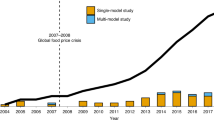Abstract
Objective: To investigate infants' energy intake and growth in a population with a high frequency of breast-feeding and high birth weight.
Design: The infants' consumption was recorded once a month from 1 to 12 months of age. At the ages of 2, 4, 6, 9 and 12 months all ingested food was weighed accurately to calculate nutrient intake. A control group participated at the age of 9 months.
Setting: Participants, who were born healthy, were recruited from four different maternity wards. Growth data were collected from healthcare centres and consumption data with parents' assistance from the infants' homes.
Subjects: Infants (n=250) were randomly selected and divided into a research group (n=180) and a control group (n=70). The research group participants numbered 138 (77%) and the control participants 57 (81%).
Results: Energy intake was lower than current recommendations but was similar to that found in recent studies. Growth, as a percentage of birth weight, correlated negatively with birth weight, with r=0.77 (P<0.001) for growth to 12 months. Infants breast-fed at 7 months of age gained less weight from 6 to 9 months, 1057±58 g, than those not breast-fed, 1498±130 g (P<0.001). Analysis of the control group's intake showed that participation in the study did not affect intake.
Conclusion: The findings support the need for new recommendations on energy intake and new growth charts based on current knowledge about breast-fed infants. Birth weight is a determining factor of growth in infancy, and percentage weight gain during the first year of life increases as birth weight decreases.
Sponsorship: The Icelandic Research Council, The Research Fund of the University of Iceland, The Icelandic Nutrition Council, The Students' Innovation Fund, The Icelandic Dairy Marketing Board
European Journal of Clinical Nutrition (2000) 54, 695–701
This is a preview of subscription content, access via your institution
Access options
Subscribe to this journal
Receive 12 print issues and online access
$259.00 per year
only $21.58 per issue
Buy this article
- Purchase on Springer Link
- Instant access to full article PDF
Prices may be subject to local taxes which are calculated during checkout
Similar content being viewed by others
Author information
Authors and Affiliations
Contributions
Guarantor: I Thorsdottir.
Contributors: HA is a research assistant and student. IT is a professor of human nutrition, project leader and Atladottir's supervisor.
Corresponding author
Rights and permissions
About this article
Cite this article
Atladottir, H., Thorsdottir, I. Energy intake and growth of infants in Iceland—a population with high frequency of breast-feeding and high birth weight. Eur J Clin Nutr 54, 695–701 (2000). https://doi.org/10.1038/sj.ejcn.1601078
Published:
Issue Date:
DOI: https://doi.org/10.1038/sj.ejcn.1601078
Keywords
This article is cited by
-
Early-life exposures and age at thelarche in the Sister Study cohort
Breast Cancer Research (2021)
-
Early feeding and risk of Juvenile idiopathic arthritis: a case control study in a prospective birth cohort
Pediatric Rheumatology (2017)
-
Study protocol: Mother and Infant Nutritional Assessment (MINA) cohort study in Qatar and Lebanon
BMC Pregnancy and Childbirth (2016)
-
Persistence of the effect of birth size on dysglycaemia and type 2 diabetes in old age: AGES-Reykjavik Study
AGE (2013)
-
Iron status of one-year-olds and association with breast milk, cow’s milk or formula in late infancy
European Journal of Nutrition (2013)



